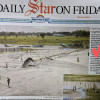River-filling easier now

Dredging of the rivers under the 'Circular Waterway' project facilitated encroachment on the rivers, riverbanks, floodplains, canals and other wetland as the grabbers could easily bring sand on cargo boats.
The Bangladesh Inland Water Transport Authority (BIWTA) dredged some rivers for developing the circular waterway. Now around 10,000 cargo boats are operating in and around the capital and most of them are serving the purpose of land developers.
The sand and soil carrying cargo boats, locally known as 'bolget', are the main transports operating on these river routes.
The housing companies used to fill up the southern and eastern side of the capital a few years ago. But now they are filling up the wetland and rivers in the northern parts. The 'bolgets' could not reach the northern parts as it was impossible for them to ply in the Turag then.
"But the government excavated the rivers for the Circular Water Way and now these boats can easily ply in there. So the riverbanks and other wetland are being filled up very quickly," says a BIWTA official speaking anonymously.
The private housing companies and earth fillers prefer 'bolgets' as each boat carries 5,000 to 10,000 cubic feet of sand at a time.
"If someone wants to carry 10,000 CFT of sand on trucks he will need at least 100 trucks," said an official working with a housing estate who does not want to be identified.
Developers say around 10,000 'bolgets' are carrying sand and earth to fill up wetland, floodplains and the rivers around the city.
Sources in the Ministry of Shipping say there are around 5,000 registered water vessels in the capital, most of which are mainly serving the purpose of 31 housing companies and private housing initiatives to fill up land.
Sometimes the cargo boats create such obstacles in the river routes that other modes of transport cannot move properly. In recent years, accidents on river routes around the capital have increased thanks to these boats.
When these boats are loaded, the upper deck almost goes down the water level. This makes it hard for other water transports to identify them at night and accidents occur as a result.
A couple of years ago BIWTA imposed a ban on plying of 'bolgets' at night so that other vessels don't face any obstacle.
No fishermen or fishing boats were visible during several visits to the Buriganga, Shitalakhya, Balu and Turag rivers in recent weeks. Only there were some dredgers and 'bolgets' either to fill up land or collect sand to fill up other parts of the rivers elsewhere.

Recently, The Daily Star published a series of reports on riverbed and riverbank filling. During investigation, it was found that all the filling was taking place by boats.
BIWTA Secretary Syed Monowar Hossain said they are taking preparations to evict all illegal grabbers.
"We won't allow anyone to illegally fill up the riverbanks, even if it is their own land. We'll go by the port act and rules and regulations applicable for the rivers," he said.
As the BITWA and other authorities sit idle, both the sides of the Dhaka flood protection embankment from Kamrangirchar to Gabtali through Rayer Bazar have meanwhile been filled up.
Some government agencies are also violating the laws and filling up the wetland.
The Rajdhani Unnayan Kartripakkha (Rajuk) has taken up its Uttara third phase project after dredging the Turag. They also dredged the river and used 'bolgets' to fill up wetland for the purpose.
Different housing estates occupied and filled up Dangurdia, Durdi, Vatara, Telikhola and Brahmankhola canals in Satarkul and Vatara unions under Badda police station in the last five years.
Rashidkhali canal, one of the most important canals in eastern Dhaka, was once 10 kilometres long and connected the Norai river. Different housing companies have filled up around eight kilometres of this canal.
The grabbers have also filled up canals from Meradia to Nandipara in recent years using the river route.
They have also made attempts to fill up areas from Gabtali to Ashulia towards Tongi.

 For all latest news, follow The Daily Star's Google News channel.
For all latest news, follow The Daily Star's Google News channel. 







Comments